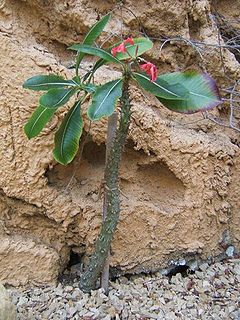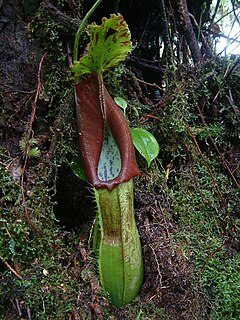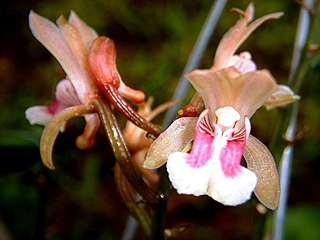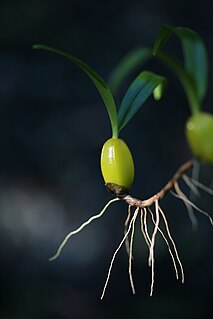Pachypodium ambongense belongs to the dogbane family Apocynaceae, which has recently been merged with the milkweed family Asclepiadaceae. It was first published as a species of the genus Pachypodium in 1924 by the botanist Henri Louis Poisson.

Madagascar palm, also known as bontaka, is a flowering plant in the Dogbane family Apocynaceae. It has the habit of a robust shrub with a spherical or bottle-shaped trunk. It has several cylindrical branches at the top.
Pachypodium bicolor belongs to the dogbane family Apocynaceae, now merged with the milkweed family Asclepiadaceae, a move with great botanical implications to succulent enthusiasts.

Nepenthes jamban is a tropical pitcher plant endemic to northern Sumatra. The specific epithet jamban is the Indonesian word for "toilet" and refers to the shape of the pitchers.

Nepenthes naga is a tropical pitcher plant endemic to the Barisan Mountains of Sumatra. It is characterised by a forked sub-apical appendage on the underside of the lid and an undulate lid margin. The specific epithet naga is the Indonesian word for "dragon" and refers to the distinctive lid appendage of this species as well as the large size of its pitchers. The name also references local folklore, which tells of dragons occurring in this species's habitat in the past.

Eulophila pulchra, commonly known as the gonzo orchid, is a plant in the orchid family and is native to areas from Tanzania and Mozambique to the Western Pacific Ocean. It is a terrestrial orchid with crowded, above-ground pseudobulbs, two or three leaves and pale yellowish green flowers with dull purple or red markings. It grows in plant litter in rainforests.

Bulbophyllum baileyi, commonly known as the fruit fly orchid, is a species of epiphytic or lithophytic orchid that is native to Queensland and New Guinea. It has coarse, creeping rhizomes, curved, yellowish pseudobulbs with a single thick, fleshy leaf, and a single cream-coloured flower with yellow, red or purple spots. It grows on trees and rocks in open forest, often in exposed places.

Bulbophyllum grandimesense, commonly known as the pale rope orchid, is a species of epiphytic orchid with well-spaced pseudobulbs and brown bracts arranged along the stems. Each pseudobulb has a single, fleshy, dark green leaf and usually only a single white flower with thread-like tips on the sepals. It grows on rainforest trees in a small area of tropical North Queensland.
Bulbophyllum johnsonii, commonly known as the yellow snake orchid, is a species of epiphytic or lithophytic orchid that has a thin, creeping rhizome with flattened pseudobulbs, each with a single tough, dark green leaf and a single bright yellow to orange flower on a thread-like stalk. It grows on trees, shrubs and rocks in and near rainforest in tropical North Queensland.
Bulbophyllum lamingtonense, commonly known as the cream rope orchid, is a species of epiphytic or lithophytic orchid with well-spaced pseudobulbs and brown bracts arranged along the stems. Each pseudobulb has a single, fleshy, channelled leaf and a single cream-coloured or white flower with yellow tips. It grows on trees and rocks near cliffs and the edge of rainforest near the eastern border between New South Wales and Queensland.

Bulbophyllum longiflorum, commonly known as the pale umbrella orchid, is a species of epiphytic or lithophytic orchid. It has a creeping rhizome, widely spaced, dark green pseudobulbs with a single large, fleshy leaf, and flowers spreading in a semicirclar umbel, resembling one-half of an umbrella. The flowers are canoe-shaped, greenish cream-coloured to yellowish with purple dots. It has a wide distribution and is found in parts of Africa, on islands in the Indian and Pacific Oceans, Southeast Asia, New Guinea and northern Australia.
Bulbophyllum nematopodum, commonly known as the green cowl orchid, is a species of epiphytic or lithophytic orchid that has small, flask-shaped pseudobulbs pressed against the surface on which it grows. Each pseudobulb has roots at its base, a single shiny, fleshy leaf and a single cream-coloured flower with red spots on its top. It grows on trees and rocks in rainforest and is endemic to tropical North Queensland.

Bulbophyllum wadsworthii, commonly known as the yellow rope orchid, is a species of epiphytic or lithophytic orchid that forms clumps that hang off the surface on which the plant is growing. The pseudobulbs are small and partly hidden by brown, papery bracts. Each pseudobulb has a single fleshy, dark green leaf and a single star-shaped, cream-coloured or pale green flower with an orange labellum. It mainly grows on trees and rocks in rainforest and is endemic to Queensland.
Oeceoclades ambrensis is a terrestrial orchid species in the genus Oeceoclades that is endemic to northern Madagascar, where it grows in humid forests at altitudes of 1,000–1,100 metres (3,300–3,600 ft). It was first described by the French botanist Joseph Marie Henry Alfred Perrier de la Bâthie in 1951 as Lissochilus ambrensis and moved to the genus Eulophia in 1975 by Friedhelm Reinhold Butzin. It was last transferred to the genus Oeceoclades in 2001 by Jean Marie Bosser and Philippe Morat. The type specimen was collected in 1924 from montagne d'Ambre, now a part of Amber Mountain National Park. The pseudobulbs are fusiform (spindle-shaped) and homoblastic. Oeceoclades ambrensis is most similar to O. pulchra but it differs in the structure of the labellum, having rounded lobes.
Oeceoclades flavescens is a terrestrial orchid species in the genus Oeceoclades that is endemic to northeastern Madagascar. It was first described by the French botanists Jean Marie Bosser and Philippe Morat in 2001. The type specimen was collected in 1954 from the wet undergrowth of a coastal forest near Maroantsetra; it is the only known collection of this species. The specific epithet flavescens refers to the pale yellow flowers.
Oeceoclades humbertii is a terrestrial orchid species in the genus Oeceoclades that is endemic to southeastern Madagascar, where it grows in xerophilous bush at altitudes from 500 to 600 m. It was first described by the French botanist Joseph Marie Henry Alfred Perrier de la Bâthie in 1939 as Lissochilus humbertii and moved to the genus Eulophia in 1975 by Friedhelm Reinhold Butzin. It was last transferred to the genus Oeceoclades in 2001 by Jean Marie Bosser and Philippe Morat. The type specimen was collected from the left bank of the Manambolo valley in the Mandrare River basin in either December 1933 or January 1934 when it was recorded as flowering by its collector Jean-Henri Humbert for whom the specific epithet humbertii honors. The small pseudobulbs are conical and heteroblastic. Oeceoclades humbertii is distinguished from all other Oeceoclades by its completely green flowers. It has only been collected twice including the type specimen; the other specimen was collected by Philippe Morat in 1973 from the Onilahy valley in the Ankazoabo gorges north of Betioky.
Oeceoclades longebracteata is a species of terrestrial orchid in the genus Oeceoclades that is endemic to southwestern and south-central Madagascar. It was first described by the French botanists Jean Marie Bosser and Philippe Morat in 2001. The type specimen was collected in 1970 by Jean Marie Bosser from dry forest undergrowth near Tsaramasao, 20 km (12 mi) south of Sakaraha. The specific epithet longebracteata refers to the long bracts found along the inflorescence.
Oeceoclades peyrotii is a species of terrestrial orchid in the genus Oeceoclades that is endemic to southwestern Madagascar. It was first described by the French botanists Jean Marie Bosser and Philippe Morat in 2001. The type specimen was collected in 1974 by Bosser and Morat from the woods near Ankazoabo, but it has also been found 40 km (25 mi) south of Sakaraha, near Mahaboboka, and near Morombe. The specific epithet peyrotii was given to this species in honor of Dr. Jean-Pierre Peyrot whose observations and collections have led to a better understanding of Malagasy orchids.
Pterostylis furcata, commonly known as the forked greenhood, is a species of orchid endemic to Tasmania. Flowering plants have a rosette of bright green leaves at the base of the flowering stem and a single green and white flower with the tip of the dorsal sepal pointing above the horizontal.













